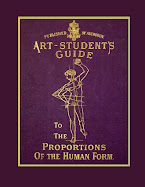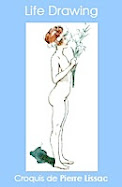in translation: GOTTFRIED SCHADOW ARTICLES AND LETTERS OF and a list WORKS HIS BIRTH CENTENARY CELEBRATION OF HIS 20th May 1764 PUBLISHED BY JULIUS FRIED COUNTRIES.
Among other interesting facts about his life and work was that the 1930s were a very prolific time in terms of his preparation of the teaching materials which form the basis for The Art Student's Guide to the Proportions of the Human Form
Here is a translation of a list of his written works in the 1930s:
1830
9th. Study of the bones and muscles of the conditions of the human body, and foreshortening. In thirty panels for use in the Royal Academy of Arts, Berlin 1830, large folio.
A leaf initiation, lithographed, like the panel is signed by G. Schadow and F. Berger. Several other panels contain only declarations.
1834
10th. Atlas of Polyclet of the measurements of people by gender and age, indicating the real nature of size after the Rhenish ruler, and paper by the difference of the face and head formation of the peoples of the earth, by Gottfried Schadow. - Polyclete ou theorie des mesures de l'homme etc. Berlin 1834th 4 °. l'III and 100 pages (German and French side by side).
This in large folio atlas with 29 unnumbered plates Jnhaltsverzeichniss. (These are signs of Schadow himself drawn on zinc.)
In the museum, leaves of Fine Art, edited by F. Kugler, fourth year, 1836, No. 5, is a critique of this and the following work.
1835
11th. -National Physionomy or observations about the difference, the facial features and the external design of the head, the outlines depicted on 29 sheets, continuation of Polyclet or the doctrine of the ratios of the human body, by Gottfried Schadow. - Physionomies national etc. Berlin 1835th 4 °. VI and 112 pages (German and French side by side). This atlas of 29 plates with a Table of contents (these panels are drawn on zinc by Schadow himself).
1843
12th. report on the performance of live images, which in the Hall of K. Academy of Arts', u Berlin on 5 Took place in May 1843 (relation etc). booklet in cross-Quart, 15 pages, German and French side by side (the preface is signed by Schadow). 6 zincography leaves, each of which contains two images.
"From the 'program in this issue appears that goods among the four Schadow representations: the group of the two Prussian princesses, Fortuna, Adam and Eve, Venus. Shown and discussed here is not the same, so it is not known whether the last fdrei were represented by executed works or designs.
See works of art and art views p. 337
13th. artwork and art views by Dr. Johann Gottfried Schadow. Berlin 1849th 8 °. Xxvi and 376 pages.
These images include a booklet entitled: Presentation by the images of the work of the sculptor Johann Gottfried Schadow, Ridolfo Schadow his son, and transparent picture of the professor piston nacb poems of Wolfgang von Goethe. Berlin 1849th 8 pages Folio XXXIII "leaves" images (there are several images on one page and printed uncut, so that there are truth Folio 29 boards in).
You can see the German text of the description of the plates of Polyclet; oder, von den Maassen des Menschen nach dem Geschlechte und Alter at Google Books in an 1877 edition or an 1886 edition but the only edition with the plates is my edition which is a new version of the 1883 English translation with plates reproduced by John Sutcliffe and a translation by James J. Wright. You can see it at Amazon.com
The Art Student's Guide To The Proportions Of The Human Form
The Art Student's Guide to the Bones and Muscles of the Human Body: and Lessons on Foreshortening





















No comments:
Post a Comment